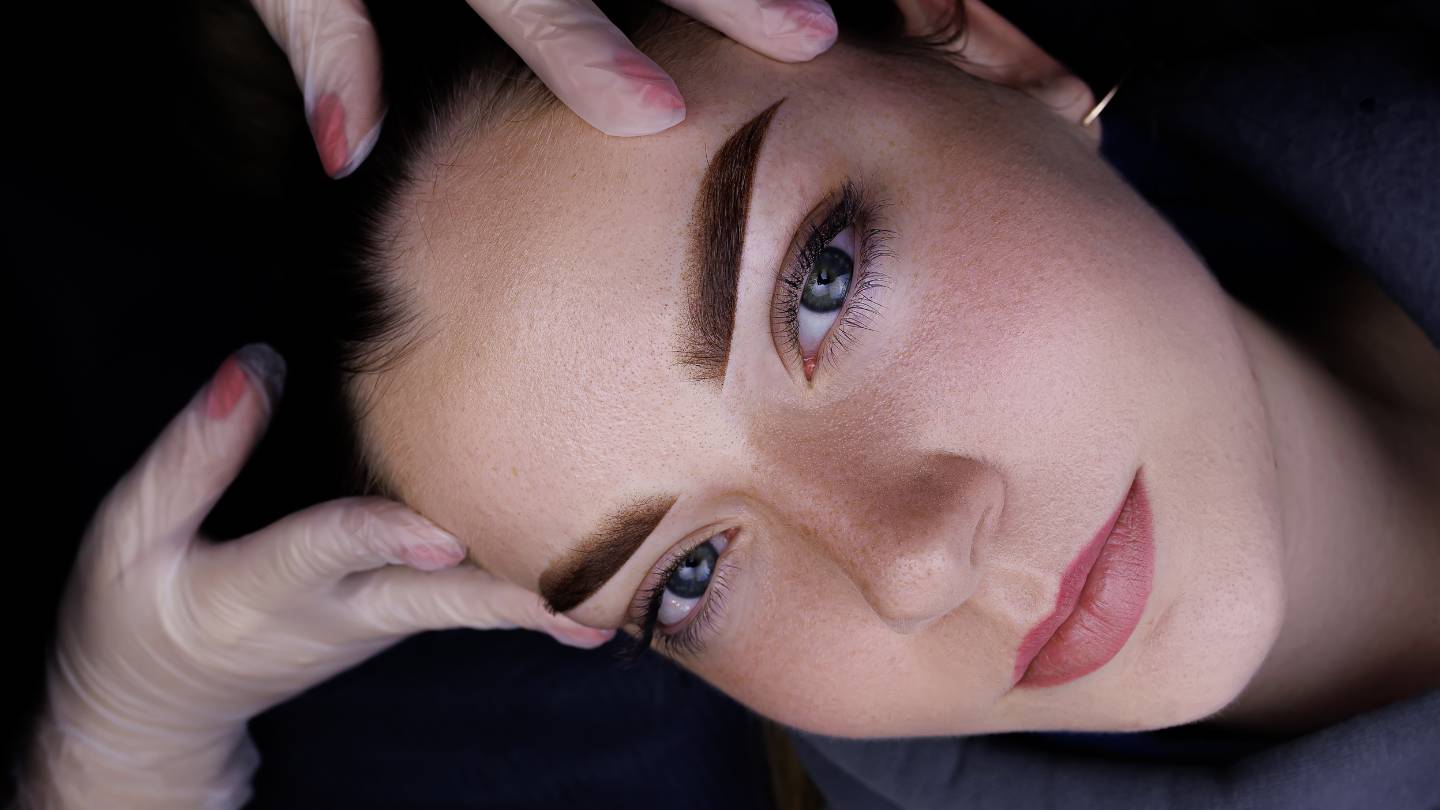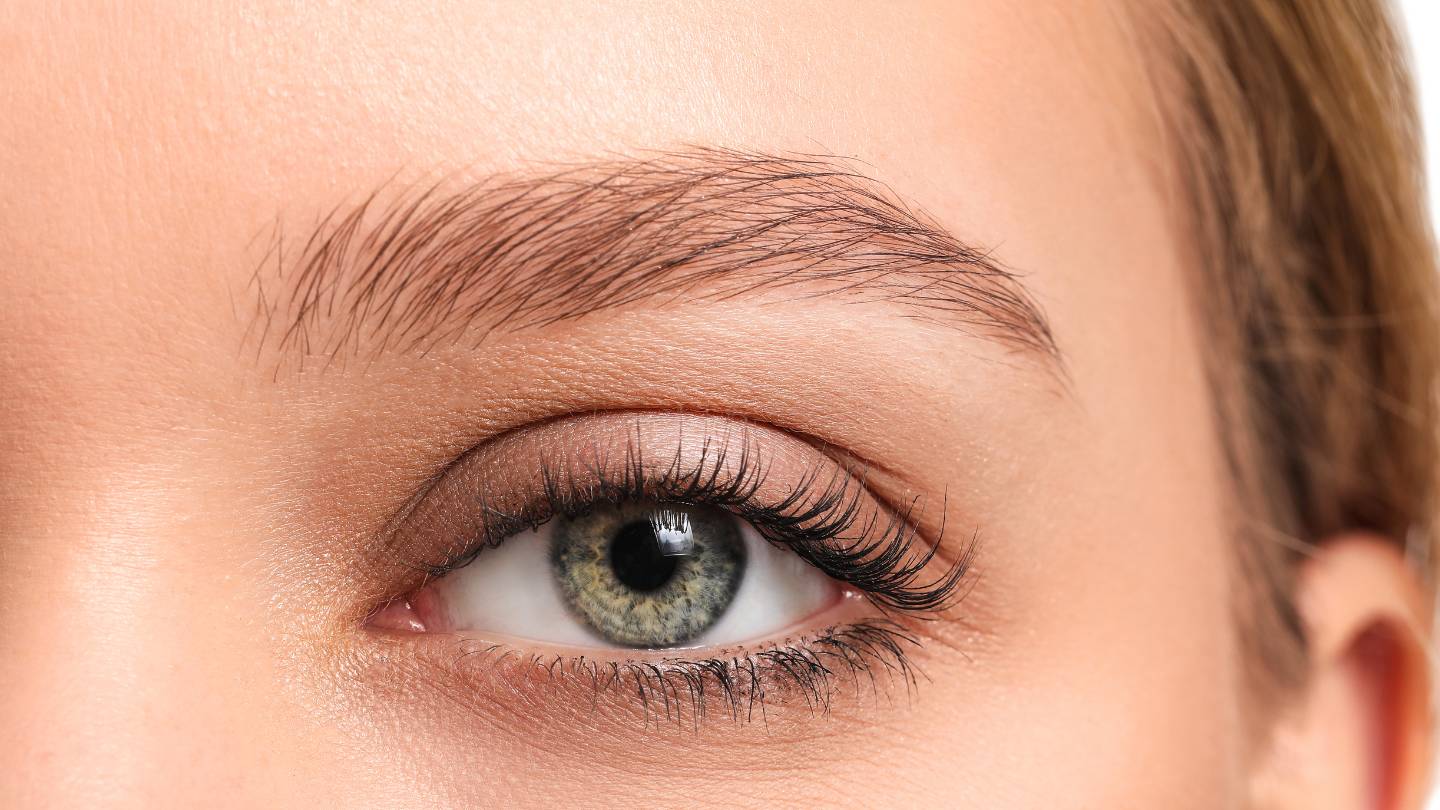To help you make the best decision for your brow augmentation journey, we offer both eyebrow feathering and microblading. In pursuing the ideal, undetectable eyebrow enlargement, familiarising yourself with the similarities and contrasts between these two revolutionary procedures is essential.
Two popular beauty trends changing how people look are eyebrow feathering and microblading, which are semi-permanent ways to get perfectly shaped and defined eyebrows. Both methods require carefully putting pigments into the skin to make it look like each eyebrow hair is separate, but they work in different ways and produce different results.
Eyebrow feathering, often called feather touch or 3D brows, is a delicate manual technique that uses a small blade to mimic the natural development pattern of your brows. The strokes are soft and feathered. This technique is well-known for subtly enhancing your eyebrows while blending in with your natural hair.
Microblading, conversely, employs a specialized handheld instrument to produce imitative natural hairs with their refined, razor-sharp texture. Ideal for those in search of a more arched, defined brow appearance, it is marginally more structured and defined.
Microblading and Eyebrow Feathering: What You Need to Know
In recent years, eyebrow enhancement techniques like microblading and eyebrow feathering have gained significant popularity. These methods offer an appealing solution for those seeking more defined and expressive brows, thereby enhancing facial features.
Microblading: The Process Explained
Microblading, a semi-permanent tattooing technique, involves the meticulous drawing of eyebrow hairs to create a fuller appearance. This method is particularly beneficial for individuals with sparse or thinning eyebrows, including those affected by conditions like alopecia.
Suitability for Microblading
Ideal candidates for microblading are those lacking natural eyebrow hair. However, it's not suitable for everyone. Individuals with heart conditions, diabetes, skin diseases, or recent cosmetic procedures such as chemical peels or Botox should approach microblading with caution.
The Microblading Procedure
Microblading begins with a consultation to design the desired eyebrow shape. A technician then uses a fine needle tool to implant pigment into the skin, mimicking natural hairs. The procedure typically takes 1.5 to 3 hours, with a follow-up session recommended for touch-ups and adjustments.
Potential Risks of Microblading
Despite its popularity, microblading carries risks such as infection and scarring. It's crucial to adhere to aftercare instructions and consult a physician if you have any health concerns or are pregnant.
Pain Level and Duration of Microblading
Pain tolerance varies among individuals. While some may opt for a topical anesthetic, professionals cannot legally apply certain types of anesthesia. The effects of microblading last between one to three years, with colour fading over time.
Eyebrow Feathering: An Alternative Technique
Eyebrow feathering, also known as microfeathering, offers a less invasive approach than microblading. This technique involves creating fine incisions and depositing pigment to enhance the natural look of the eyebrows.
Risks Associated with Eyebrow Feathering
Similar to microblading, eyebrow feathering carries a risk of infection and requires strict adherence to aftercare instructions. Possible side effects include redness, swelling, itching, and bruising.
Ideal Candidates for Eyebrow Feathering
Eyebrow feathering is most effective for individuals with naturally thick eyebrows that have sparse areas. Those with oily skin might experience issues with pigment absorption and are advised to consider their skin type before proceeding.
The Eyebrow Feathering Process
A consultation is essential for assessing the natural hair density of the eyebrows. The technique involves creating hair-like incisions and depositing colour into the skin's upper layer. A second session is usually needed to enhance the colour and fill any gaps.
Managing Pain in Eyebrow Feathering
Pain levels are subjective, and those concerned about discomfort can use a topical anaesthetic. However, most find the process to be minimally painful.
Eyebrow Feathering Vs Microblading: The Distinct Differences
When contrasting microblading with eyebrow feathering, several important distinctions become apparent:
Technique
The main distinction is in the methods and equipment that are utilised. Microblading relies on a manual hand tool to create precise cuts in the skin, whereas eyebrow feathering uses computerised equipment to generate fine, hair-like strokes.
Aesthetic Outcome
The result of each method is different. Feathering your eyebrows creates a delicate effect that draws attention to your natural brows without drawing too much attention to them. In contrast, microblading produces a more defined and sculpted brow, making it an excellent choice for individuals who want a more dramatic change.
Longevity
Microblading and eyebrow feathering have different results regarding how long they last. Skin type, lifestyle, and aftercare routine are a few variables that determine how long the results of feathering and microblading persist. The former typically lasts up to a year, while the latter can last up to two years.
Healing and Pain
Because it is less invasive, eyebrow feathering is often considered a less painful alternative to microblading. Feathering typically heals more quickly as a result. Because it is a more intrusive process, microblading could make the patient more uncomfortable and lengthen the time it takes to recuperate.
Ideal Candidates
Those looking for a mild, natural augmentation and those with dry to normal skin types are ideal for eyebrow feathering. If you want a more dramatic, defined eyebrow style or have oily skin, microblading is usually a better option.
Feathering and Microblading Pros and Cons
Microblading
PROS
It does fill your brows.
Remember that microblading can fill in sparse parts of your eyebrow hair while giving the illusion of full brows, as discussed before.
Rest Certain, It Will Survive For 1-3 Years
The duration of microblading can range from one to three years, though those with oily skin should be cautious. That's a fair lot of time to go without touching your brows. Touch-ups should be done once every year or so to maintain the appearance of natural eyebrow hairs.
It's Not Super Painful
We categorised this as a "pro" because, given its resemblance to a real tattoo, microblading is likely to inflict significant discomfort. My pals assure me that it's not painful at all. With the numbing cream your brow expert can apply (don't be a hero; utilise the cream), the discomfort will be about the same as a mildly uncomfortable session of tweezing your eyebrows.
CONS
Healing And Downtime
It is normal to arrive with enormous, SUPER DARK eyebrows in the first few days. Expect redness, scabbing, edema, and other symptoms for approximately one week following the treatment; therefore, you must make appropriate preparations. Additionally, you are prohibited from wetting your eyebrows, excessively sweating, and sunbathing for one week following your treatment. It merely necessitates some preliminary preparation—not an insignificant detail, but something to contemplate.
You Can't Expect Everybody to Be Perfect
This is why talking to a professional about your brows is important before you get any brow product. Some people won't be suitable candidates, such as those with extremely sensitive skin or skin problems like cystic acne in that region. Worried about your skin's oiliness? You may not get the most out of microblading if your skin tends to be oily because the pigments can fade quickly.
Feathering
PROS
Very Little Downtime
Since feathering uses less ink than standard microblading, no official recovery period is required. Like microblading, your brows will appear darker for a few days before returning to their natural shade.
You Look More Natural
Feathered brows are a microblading light alternative. It might be a more practical choice for those who would rather not have wildly trendy, enormous brows. If you aim to achieve fullness and symmetry in your eyebrows while maintaining their natural appearance, this is the method for you.
CONS
It's Not as Extended
On average, eyebrow feathering takes eight to eighteen months to fade, slightly longer than microblading. Just like with microblading, touch-ups are necessary.
Still Not for All Skin Types
Similar to microblading, feathering may not be the best option for individuals with particularly delicate skin, issues with the skin surrounding the eyebrow region, or excessively oily skin. It would help if you talked to a professional about your brows before you do any treatments.
Conclusion
Microblading and eyebrow feathering are two popular beauty trends that can be used to get perfectly shaped and defined eyebrows that last for a short time. Eyebrow feathering, also called feather touch or 3D brows, is a hands-on method that imitates the way eyebrows naturally grow.
Microblading, on the other hand, uses a special hand-held tool to create hairs that look like real ones and have a smooth, razor-sharp texture. Microblading can help people whose eyebrows are sparse or thinning, but it comes with risks like infection and scars. Most of the time, it takes between 1.5 and 3 hours, and you need to come back for touch-ups and changes.
Microfeathering, which is another name for eyebrow feathering, is a less invasive method that includes making small cuts and adding pigment to the eyebrows to make them look better. There is a chance of getting an infection, and you must carefully follow the aftercare directions. People who naturally have thick eyebrows and sparse areas are good candidates for eyebrow feathering. People with oily skin may have trouble absorbing the colour.
Microblading and eyebrow feathering are two different ways to make your eyebrows bigger. Microblading cuts the skin precisely with a hand tool, while eyebrow feathering uses computerised tools to make fine lines that look like hair.
When it comes to how they look, feathering gives you a more delicate look, while microblading gives you a more defined brow. With either method, the effects can last up to a year. With microblading, they can last up to two years.
Both ways are less painful, but microblading hurts more and feathering heals faster. Both work best for people who want a light, natural enhancement and for people whose skin is dry to normal. But microblading can hurt more because it looks like a tattoo, and it can last between one and three years.
Microblading doesn't hurt too much, but for about a week after the procedure, you may have redness, scabbing, swelling, and other side effects. Before you buy any lip products, you should talk to a professional because not everyone is perfect.
Feathering, on the other hand, doesn't take as long and looks more realistic. It might not work for all skin types and takes eight to eighteen months to fade.
Content Summary
- Eyebrow feathering and microblading are semi-permanent techniques for achieving well-shaped and defined eyebrows.
- Both methods involve inserting pigment into the skin to simulate individual eyebrow hairs.
- Eyebrow feathering, also known as feather touch or 3D brows, uses a manual technique with a small blade.
- This technique is known for subtly enhancing brows and blending with natural hair.
- Microblading uses a specialised handheld tool for a more structured, defined brow look.
- Microblading is ideal for those seeking a more arched, defined appearance.
- These eyebrow enhancement methods have become increasingly popular in recent years.
- Microblading involves drawing eyebrow hairs to create fullness, benefiting those with thin eyebrows.
- Microblading is suitable for individuals lacking natural eyebrow hair but not for everyone.
- Health conditions like heart issues, diabetes, or recent cosmetic procedures can affect microblading suitability.
- The microblading procedure begins with designing the eyebrow shape and takes 1.5 to 3 hours.
- A follow-up session is recommended for microblading for touch-ups and adjustments.
- Microblading carries risks like infection and scarring, requiring careful aftercare.
- Pain tolerance varies in microblading, and it lasts between one to three years.
- Eyebrow feathering is less invasive than microblading, creating a natural look.
- Risks of eyebrow feathering include infection, redness, swelling, and itching.
- Feathering is most effective for those with naturally thick but sparse eyebrows.
- Oily skin may affect pigment absorption in eyebrow feathering.
- The feathering process involves assessing natural hair density and creating hair-like incisions.
- Pain in eyebrow feathering is minimal, with the option of using a topical anaesthetic.
- Microblading creates precise cuts, whereas feathering uses computerised equipment for hair-like strokes.
- Feathering results in a delicate effect, while microblading offers a more dramatic change.
- Feathering typically lasts up to a year, while microblading can last up to two years.
- Feathering heals more quickly and is less painful than microblading.
- Ideal candidates for feathering are those seeking natural augmentation with dry to normal skin.
- Microblading is better for dramatic styles or oily skin.
- Microblading fills in sparse brows and lasts for 1-3 years.
- Regular touch-ups are needed to maintain microblading's natural appearance.
- Microblading is less painful than expected, especially with numbing cream.
- Initial healing in microblading includes dark brows, redness, and scabbing.
- Microblading is not suitable for everyone, especially those with sensitive skin or oiliness.
- Eyebrow feathering has minimal downtime and appears more natural.
- Feathered brows are a lighter alternative to microblading, ideal for a natural look.
- Feathering lasts 8-18 months, slightly shorter than microblading.
- Feathering, like microblading, may not suit all skin types.
- Feathering requires consultations and professional advice before proceeding.
- Microblading fills in sparse areas, creating an illusion of full brows.
- The longevity of microblading allows for less frequent brow maintenance.
- Microblading's pain is comparable to a mild eyebrow tweezing session.
- Microblading requires preparation for healing and downtime.
- Certain skin types, like those with cystic acne, may not be suitable for microblading.
- Oily skin can affect the durability of microblading pigments.
- Feathering requires less ink than traditional microblading.
- Feathering provides a more practical option for those seeking subtler brows.
- Touch-ups are necessary for maintaining feathering results.
- Delicate or oily skin types should consider alternatives to feathering.
- The choice between microblading and feathering depends on the desired brow style and skin type.
- Microblading offers a more noticeable, sculpted brow look.
- Feathering is ideal for those who prefer a soft, natural brow enhancement.
- Both microblading and feathering require professional assessment and individual suitability checks.
Frequently Asked Questions
The tools used for both techniques are often the same—a handheld tool with microblades or needles. However, the angle and pressure applied might vary based on the desired outcome.
Both techniques allow for a high level of customisation in shaping eyebrows according to individual preferences and facial structure.
The choice between the two techniques doesn't necessarily determine the final look; it's more about finding a skilled technician to achieve the desired natural look regardless of the terminology used.
The cost might vary based on location and technician expertise rather than the technique. Prices for both techniques are usually comparable.
Feathering and microblading can often cover or correct old tattooed eyebrows, but it requires multiple sessions and expertise to achieve the desired result.



